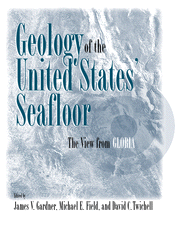Book contents
- Frontmatter
- Contents
- Contributors
- Foreword
- Introduction
- Part I The GLORIA System and Data Processing
- 1 The USGS GLORIA System
- 2 Processing and Manipulating GLORIA Sidescan Sonar Images
- Part II U. S. East Coast EEZ
- Part III Gulf of Mexico and Caribbean EEZ
- Part IV U. S. West Coast EEZ
- Part V Alaskan EEZ
- Index
2 - Processing and Manipulating GLORIA Sidescan Sonar Images
Published online by Cambridge University Press: 25 January 2010
- Frontmatter
- Contents
- Contributors
- Foreword
- Introduction
- Part I The GLORIA System and Data Processing
- 1 The USGS GLORIA System
- 2 Processing and Manipulating GLORIA Sidescan Sonar Images
- Part II U. S. East Coast EEZ
- Part III Gulf of Mexico and Caribbean EEZ
- Part IV U. S. West Coast EEZ
- Part V Alaskan EEZ
- Index
Summary
Abstract
Use of digital image data collected with remote sensing instruments has increased rapidly during the last two decades. Sidescan sonar imaging systems with digital capabilities are relatively new compared to airborne and satellite systems. The GLORIA (Geological LOng-Range Inclined Asdic) imaging system acquired digital capabilities in the early 1980s (see chapter by Somers and others in this volume for details on the GLORIA system). In this chapter we present several of the various digital image processing techniques developed by the U.S. Geological Survey (USGS) to correct, mosaic, enhance, and analyze digital sidescan sonar images. As with image data from other sensors, the processing is separated into the two different stages of preprocessing and information extraction. In the preprocessing stage, sensor-specific algorithms are applied to correct for both geometric and radiometric problems. This step is followed by digital mosaicking of the trackline strips into quadrangle format, which can be used as input to either visual or automatic digital interpretation. An automatic seamremoval procedure (ASRP) is presented as an alternative to our user-intensive digital feathering/stenciling procedure to help minimize tone-or seam-matching problems between images from adjacent tracklines.
Use of more than just local spatial variability information is important for all data sets, but especially for single-band data such as sidescan sonar. Therefore, the information extraction section discusses the generation and use of spatial variability at the local, intermediate, and regional scales for the automatic classification of GLORIA data.
- Type
- Chapter
- Information
- Geology of the United States' SeafloorThe View from GLORIA, pp. 29 - 42Publisher: Cambridge University PressPrint publication year: 1996
- 1
- Cited by



